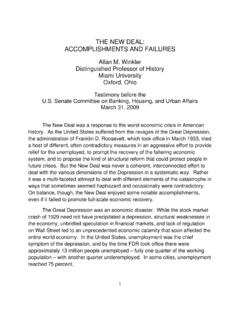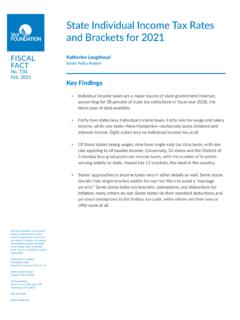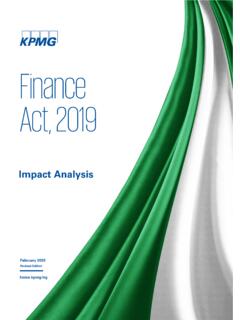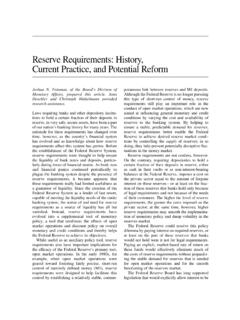Transcription of Tax Introduction to Taxation of Foreign ... - Deloitte US
1 July 2015 Introduction to the Taxation of Foreign investment in US real estateContents2 Introduction 3 Taxation of US entities and individuals 6 US tax implications of specific investment vehicles 9 Treaty protection from Taxation 11 Dispositions of US real estate investments 14 Sovereign Wealth Funds 16 Foreign Account Tax Compliance Act 18 Appendix A: Foreign corporate blocker structure 19 Appendix B: Leveraged corporate blocker structure 20 Appendix C: REIT structure 21 ContactsIntroduction to the Taxation of Foreign investment in U S real estate 1 IntroductionWays and Means Committee Chairman Paul Ryan has also publicly indicated that the House taxwriters will have an aggressive timeline for tax reform proposals this year. As of this writing, the senate finance Committee produced a bill which, in part, would liberalize the Foreign Investment in Real Property Tax Act ( FIRPTA ) rules as they apply to publicly traded REITs.
2 Among several other changes and related revenue raisers, the bill would move the FIRPTA exception for holding public REIT shares from 5% to 10%. Following this bill, Ways and Means Committee members introduced the Real Estate Investment and Jobs Act of 2015, which contained similar provisions as the senate finance Committee bill plus added a provision exempting non-US pension funds from FIRPTA. Clearly, there is relatively broad support for liberalizing remains to be seen whether the tax reform proposals being discussed by the House and senate may ultimately become legislation. While it appears that common ground is being sought on certain provisions, such as FIRPTA,this is just one portion of the comprehensive tax reform and overhaul of the entire tax code that Congress continues to debate. This debate will likely continue up through the next Presidential election in November 2016.
3 Notwithstanding the uncertainty of tax reform , the real estate industry continues to show a marked recovery in asset prices, transactions and capital availability. As such, it remains important that investors have an understanding of the tax rules currently in place in order to effectively develop a US real estate strategy. The following is an Introduction to some of the more significant tax issues that should be considered by non-US investors in this of taxes on real estateReal estate is very much a tax-driven industry. As a result, changes in US tax policy have an impact on the relative attractiveness of real estate as an investment class for non-US investors. Increases to the US tax rates on capital gains, the Taxation of the disposition of real estate, and US tax reporting requirements are often cited as examples of policies that create obstacles to investment.
4 Over the years, real estate organizations in the United States have offered proposals that would provide some relief and have sought clarification of existing rules. These efforts have met with varying degrees of success. For example, in recent years there have been numerous relief provisions added and clarifications to tax rules governing the operations of Real Estate Investment Trusts ( REITs ). However, recent efforts to modify or simplify the US tax code, including provisions addressing the Taxation of non-US investment in US real estate, have had little success. In 2014, the House Ways and Means Committee under then Chairman Dave Camp issued a discussion draft of a proposed Tax reform Act of 2014. Included in this proposal were numerous provisions to simplify and reform the US tax code. Many provisions included in this draft had been announced in previous proposals by both House and senate taxwriters but also contained new approaches for sweeping corporate and international tax reform .
5 As of the date of this publication, there has been no specific tax reform bill passed through Congress other than the Tax Increase Prevention Act on December 16, 2014 which extends for one year a number of temporary tax deductions, credits and incentives that expired at the end of the previous year. During the past year, the senate finance Committee announced that it has formed five bipartisan working groups to examine specific issues in tax reform leading up to the development of a legislative proposal for overhaul of the US tax code. The findings and recommendations of these groups were expected to be compiled in a comprehensive report to be released in 2015. Current 2 The US Internal Revenue Code ( Code ) includes provisions for the Taxation of international investors, although in some cases the tax imposed by the Code may be reduced under an applicable income tax treaty.
6 Thus, international investors normally structure their investments to take advantage of treaty benefits whenever possible. Taxation of US entities and individualsThe United States taxes its citizens, residents, and domestic corporations and trusts on all their income regardless of where it is earned, , on a worldwide basis. Noncitizens lawfully admitted to the United States as permanent residents (green card holders) or physically present in the United States for at least 183 days during any year, or a greater number of days over a three-year testing period, are considered US residents. The income tax is imposed on net income, , gross income from all sources reduced by allowable deductions, such as interest expense, taxes, and depreciation. In general, business losses in excess of income are first carried back two years and then may be carried forward 20 years to reduce income in those years, although a business may elect to waive the carryback period.
7 Currently, US corporate income tax rates range from 15% to 35%, which apply to ordinary business income as well as to capital gains. The US income tax rates for individuals and trusts are separated into tax brackets and range from 10% to Under current law, for those in the higher end income bracket, capital gains are taxed at a rate of 25% (to the extent of gain attributable to depreciation recapture) and 20% (to the extent of gain in excess of prior years depreciation). Certain qualified dividends are taxed like capital of Foreign entities and international investorsForeign corporations and trusts, and individuals who are neither US citizens nor US residents ( international investors ) are subject to US income tax only on income that is either effectively connected with a US trade or business ( effectively connected income, or ECI ), regardless of source, or, if not ECI, is US source income and gains from the sale of real estate located in the United States is US source income.
8 As a general rule, dividends and interest paid by a US corporation are US source income. In some cases, interest paid by a Foreign corporation or a Foreign or domestic partnership is also US source trade or businessIn general, a Foreign corporation or international investor that engages in considerable, continuous, or regular business activity in the United States is considered to be engaged in a trade or business within the United States. Mere ownership of unimproved real property or residential property held for personal use (for instance, an apartment or condominium) does not create a US trade or business. Further, ownership of a single piece of property rented to one tenant on a net lease basis ( , where the tenant is required to pay all expenses connected with the real estate) does not give rise to a US trade or business.
9 Leasing commercial buildings on a net lease basis may or may not create a US trade or business. Where, however, a Foreign corporation, international investor (or agents of either) actively manage commercial property and pay all expenses, taxes, and insurance, the activities constitute a US trade or partner of a partnership that is engaged in a US trade or business under the above guidelines will also be considered to be engaged in a US trade or business. Conversely, an investor who owns shares in a corporation that is engaged in a US trade or business will not be considered to be engaged in a US trade or business by virtue of the investor s share ownership. Effectively connected incomeThe effectively connected income of a Foreign corporation or international investor is taxed on a net basis at graduated rates like those applicable to US corporations, citizens, and residents.
10 Generally, US source income is ECI if one of two alternative tests the business-activities test and the asset-use test is met. The business-activities test looks to Taxation of income from US real estateIntroduction to the Taxation of Foreign investment in U S real estate 3whether the activities of the US business are a material factor in generating the income. The asset-use test looks to whether the income is derived from assets used or held for use in the conduct of a US business. Both tests are applicable to income from real estate. For example, rental income earned on a building used in a US trade or business is ECI under these a special set of rules for gains on dispositions of real property interests ( FIRPTA ), gains from the sale of a US real property interest ( USRPI ), such as real estate, or interests in partnerships, trusts, and US corporations that own primarily US real estate, are taxed as ECI regardless of whether the taxpayer is actually engaged in a US trade or business.

















